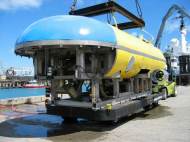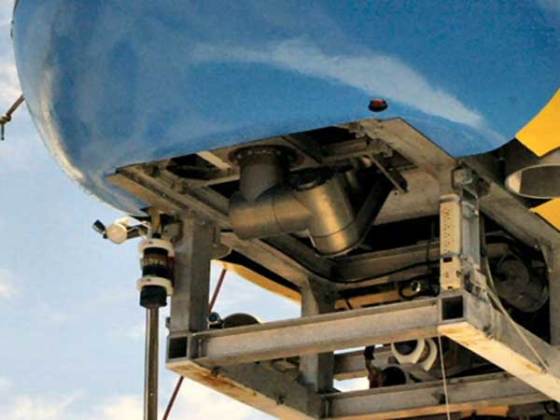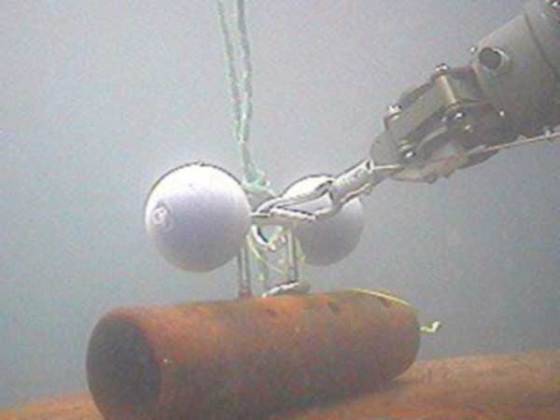SAUVIM robot completed its first fully autonomous mission
 The Autonomous Manipulation system, unlike teleoperated manipulation systems that are controlled by human operators with the aid of visual and other sensory feedback, must be capable of assessing a situation, including self-calibration based on sensory information, and executing or revising a course of manipulating action without continuous human intervention. Autonomous Systems Laboratory of the University of Hawaii and its spin-off company, MASE, Inc., have developed SAUVIM, an underwater robot capable of performing autonomous navigation and manipulation.
The Autonomous Manipulation system, unlike teleoperated manipulation systems that are controlled by human operators with the aid of visual and other sensory feedback, must be capable of assessing a situation, including self-calibration based on sensory information, and executing or revising a course of manipulating action without continuous human intervention. Autonomous Systems Laboratory of the University of Hawaii and its spin-off company, MASE, Inc., have developed SAUVIM, an underwater robot capable of performing autonomous navigation and manipulation.
SAUVIM is built around an open-framed structure enclosed by a flooded composite fairing. With six aluminum pressure vessels for housing the electronics, it has been studied in order to facilitate high-depth upgrades. The lower frame houses only the NI-MH battery pack, while the upper frame hosts all the essential electronics, visual hardware, navigation and mission sensors in six cylindrical pressure vessels.
Its movement is controlled by eight thrusters located around the center of mass. The four vertical move the vehicle in the Z-axis (heave); the two, internally mounted, horizontal thrusters move the vehicle in the Y-axis (sway); and the two, externally-mounted, horizontal thrusters move the vehicle in the X-axis (surge).
To achieve the intervention capabilities, SAUVIM is equipped with 7 degrees of freedom robotic manipulator which securely folds itself around the base in order to prevent accidental damages. The arm, is actuated by electromechanical components, in order to meet the low-power requirements and higher accuracy in manipulation tasks. The accuracy of the angular measurement is guaranteed by the combination of two resolvers, mounted respectively before and after the reduction unit. This configuration allows a sub-millimeter positioning of the manipulator’s end-effector, an important requirement when dealing with a large class of underwater intervention. Because SAUVIM is designed for underwater applications at extreme depths, the arm is internally compensated with appropriate oil.
The first fully autonomous underwater manipulation in an unstructured environment was demonstrated at the Snug Harbor, Honolulu, Hawaii on January 20, 2010. An underwater robot, SAUVIM (Semi-Autonomous Underwater Vehicle for Intervention Missions), performed autonomous navigation and manipulation. This demonstration presented a technological breakthrough in the field as autonomous manipulation had been a bottleneck issue for underwater intervention missions.
Submerged in the water, SAUVIM first performed the self-calibration routine, initializing its sub-systems. After the calibration step, SAUVIM began its pre-given mission to search for and tag an underwater object. The object’s location was roughly given. Once the vehicle reached the area surrounding the object, it started scanning the area using a DIDSON camera to locate and identify the target.
Once the object was detected, the vehicle approached it and positioned itself for optimized manipulation. Then, while the vehicle was floating in the water column, using the unified coordinated motion control of the vehicle and manipulator system, the vehicle performed an autonomous manipulation task by applying a device to the object for tagging. After completing the mission, the vehicle came back to the dock by using feature-based navigation. The whole sequence was autonomously done and the same mission was successfully repeated four times.
As the system becomes more autonomous, the user may provide only a few higher level decisional commands, interacting with the task description layer. The management of lower level functions (i.e. driving the motors to achieve a particular task) is left to the onboard system.











As always the military are at the forefront of technology whoever wields the biggest stick remains as alpha male. The kind of scenario described in the proposal however is more of a policing one. Although initially perhaps developed for military use, if successful I expect this technology to quickly transition to civilian police forces. On many levels it makes sense to use robots in risky situations chasing armed criminals, disarming kidnappers, etc. However, I expect that there will need to be legislation governing when it is appropriate to use this sort of system.